在云笔记项目学习中,提到了如何下载和上传文件,使用web的方式完成上传和下载都需要参考规范协议,代码的书写,以及web的配置,都是参考规范协议来编写的。本文将重新建立一个新Maven项目,进行简单演示,在服务端生成图片和Excel文件,发送到网页显示或实现下载,从本地上传图片或者文件到服务器,然后写出到目标文件夹。
文件上传与下载相关参考协议
(1)文件上传参考协议:Form-based File Upload in HTML RFC1867
(2)文件下载参考协议:Hypertext Transfer Protocol HTTP/1.1 RFC2616
(3)Spring-framework参考文档:https://docs.spring.io/spring/docs/4.3.23.RELEASE/spring-framework-reference/htmlsingle/
其他协议:
(1)UDP协议:User Datagram Protocol(UDP) RFC768 ,以前学习的UDP编程基于此
(2)TCP协议:Transmission Control Protocol(TCP) RFC793,以前学习的socket就是基于此文章
(3)HTTP/1.0版本协议:Hypertext Transfer Protocol HTTP/1.0 RFC1945,是HTTP/1.1以前的版本
(4)HTTP状态管理协议:HTTP State Management Mechanism RFC6265,其中Cookie就在里面说明
本项目参考的协议只有上传和下载协议,以及Spring-framework参考文档。
项目搭建
Step1 导包,项目需要导入Spring-MVC包、poi包、Commons-fileupload包、jackson核心包、pom.xml中进行配置
1 <project xmlns="http://maven.apache.org/POM/4.0.0" xmlns:xsi="http://www.w3.org/2001/XMLSchema-instance" xsi:schemaLocation="http://maven.apache.org/POM/4.0.0 http://maven.apache.org/xsd/maven-4.0.0.xsd"> 2 <modelVersion>4.0.0</modelVersion> 3 <groupId>com.boe</groupId> 4 <artifactId>FileUploadAndDownLoad</artifactId> 5 <version>0.0.1-SNAPSHOT</version> 6 <packaging>war</packaging> 7 8 <dependencies> 9 <!-- 导入spring-MVC --> 10 <dependency> 11 <groupId>org.springframework</groupId> 12 <artifactId>spring-webmvc</artifactId> 13 <version>4.2.3.RELEASE</version> 14 </dependency> 15 16 <dependency> 17 <groupId>org.springframework</groupId> 18 <artifactId>spring-webmvc</artifactId> 19 <version>4.2.3.RELEASE</version> 20 <classifier>sources</classifier> 21 </dependency> 22 23 <dependency> 24 <groupId>org.springframework</groupId> 25 <artifactId>spring-webmvc</artifactId> 26 <version>4.2.3.RELEASE</version> 27 <classifier>javadoc</classifier> 28 </dependency> 29 30 <!-- 导入poi包,创建excel用 --> 31 <dependency> 32 <groupId>org.apache.poi</groupId> 33 <artifactId>poi</artifactId> 34 <version>3.17</version> 35 </dependency> 36 37 <dependency> 38 <groupId>org.apache.poi</groupId> 39 <artifactId>poi-ooxml</artifactId> 40 <version>3.17</version> 41 </dependency> 42 43 <!-- 导入commons-fileupload包,用于文件上载 --> 44 <dependency> 45 <groupId>commons-fileupload</groupId> 46 <artifactId>commons-fileupload</artifactId> 47 <version>1.3</version> 48 </dependency> 49 50 <!-- 导入json和java对象转换的jackson包 --> 51 <!-- 导入jackson-core --> 52 <dependency> 53 <groupId>com.fasterxml.jackson.core</groupId> 54 <artifactId>jackson-core</artifactId> 55 <version>2.2.3</version> 56 </dependency> 57 58 <!-- 导入jackson-databind --> 59 <dependency> 60 <groupId>com.fasterxml.jackson.core</groupId> 61 <artifactId>jackson-databind</artifactId> 62 <version>2.2.3</version> 63 </dependency> 64 65 <!-- 导入jackson-annotations --> 66 <dependency> 67 <groupId>com.fasterxml.jackson.core</groupId> 68 <artifactId>jackson-annotations</artifactId> 69 <version>2.2.3</version> 70 </dependency> 71 72 </dependencies> 73 74 </project>
step2 配置Spring-mvc.xml,除了配置组件扫描和注解驱动,由于项目上传文件需要用到Spring的解析器MultipartResolver,因此还需要进行上传解析器配置,里面设置上传的最大文件大小,以及文件名编码方式和最大文件内存保存大小等属性,后面将有用。
1 <!-- 配置组件扫描 --> 2 <context:component-scan base-package="Web"></context:component-scan> 3 <!-- 添加注解驱动 --> 4 <mvc:annotation-driven></mvc:annotation-driven> 5 6 <!-- 配置文件上载解析器MultipartResolver --> 7 <bean id="multipartResolver" class="org.springframework.web.multipart.commons.CommonsMultipartResolver"> 8 <!-- one of the properties available; the maximum file size in bytes --> 9 <!-- 通过set方法设置以下两个父类属性,父类为CommonsFileUploadSupport.class --> 10 <property name="maxUploadSize" value="10000000"/> <!--10M大小 --> 11 <property name="defaultEncoding" value="UTF-8" /> <!-- 文件名编码,可以适用于中文名 --> 12 13 <property name="maxInMemorySize" value="10000000" /> 14 <!-- 上传文件大小默认小于10kib时,会将文件写入硬盘前保存在内存中,否则就不会保存在内存中 --> 15 </bean>
step3 配置Servlet,其中使用部署描述文件来自动配置,DispatcherServelet会自动启动Spring-MVC,因此不需要新建一个类,直接使用存在的Spring下的DispatcherServelet即可,并设置参数,和路径请求条件。
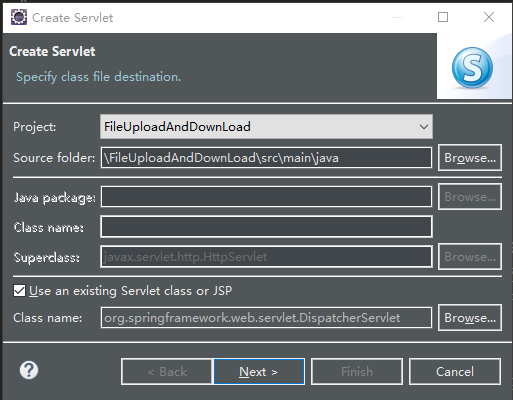
配置完成后的web.xml文件内容,就包含部署描述文件自动生成的部分。
1 <?xml version="1.0" encoding="UTF-8"?> 2 <web-app xmlns:xsi="http://www.w3.org/2001/XMLSchema-instance" xmlns="http://java.sun.com/xml/ns/javaee" xsi:schemaLocation="http://java.sun.com/xml/ns/javaee http://java.sun.com/xml/ns/javaee/web-app_2_5.xsd" version="2.5"> 3 <display-name>FileUploadAndDownLoad</display-name> 4 <welcome-file-list> 5 <welcome-file>index.html</welcome-file> 6 <welcome-file>index.htm</welcome-file> 7 <welcome-file>index.jsp</welcome-file> 8 <welcome-file>default.html</welcome-file> 9 <welcome-file>default.htm</welcome-file> 10 <welcome-file>default.jsp</welcome-file> 11 </welcome-file-list> 12 <!-- 手动配置的servlet --> 13 <servlet> 14 <description></description> 15 <display-name>ImageServlet</display-name> 16 <servlet-name>ImageServlet</servlet-name> 17 <servlet-class>Web.ImageServlet</servlet-class> 18 </servlet> 19 <servlet-mapping> 20 <servlet-name>ImageServlet</servlet-name> 21 <url-pattern>/demoImg</url-pattern> 22 </servlet-mapping> 23 <!-- 使用部署描述文件生成,不用新建一个专门的servlet,而是勾选"选择已经存在的servlet或JSP来配置" --> 24 <!-- 使用DispatcherServlet来帮忙加载配置文件,启动Spring容器 --> 25 <servlet> 26 <description></description> 27 <display-name>DispatcherServlet</display-name> 28 <servlet-name>DispatcherServlet</servlet-name> 29 <servlet-class>org.springframework.web.servlet.DispatcherServlet</servlet-class> 30 <init-param> 31 <description></description> 32 <param-name>contextConfigLocation</param-name> 33 <param-value>classpath:config/spring-*.xml</param-value> 34 </init-param> 35 <load-on-startup>1</load-on-startup> 36 </servlet> 37 <servlet-mapping> 38 <servlet-name>DispatcherServlet</servlet-name> 39 <url-pattern>*.do</url-pattern> 40 </servlet-mapping> 41 </web-app>
完成以上配置后,就可以写控制器,以及网页来进行测试,最后测试完成后项目结构如下图:
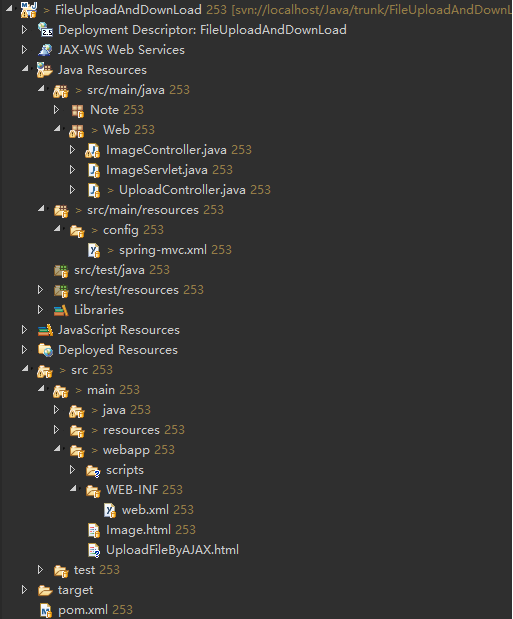
RFC2616协议参考
服务器给浏览器发送数据时,先发送状态行,再发送响应头和消息body,可以参考RFC2616超文本传输协议内容。
例子:如果发送一个网页给Client,简单的将包含如下几部分
HTTP/1.1 200 OK
ContentType:text/html charset=utf-8
ContentLength:203
空一行
<html>内容</html>
状态行(Status-Line)
Status-Line = HTTP-Version SP Status-Code SP Reason-Phrase CRLF
状态行包括HTTP版本号,状态码,和状态码的建议描述等信息,其中状态码是三位的数字,第一位数字用于分类,其他没有分类功能。此外Client端只检查状态码,不会检查状态码的描述,描述主要是给人看的。关于状态码,有如下几类:
1XX: Informational,请求接受继续执行
2XX: Success,请求被成功接受,解释,以及被接收
3XX: Redirection,为了完成当前请求,需要进行进一步的请求
4XX: Client Error,请求包含错误语法或者不能被实现
5XX: Server Error,服务端不能处理包含正确语法的请求
响应头(Entity Header Fields)
响应头里的ContentType定义了消息Body里的数据类型,根据RFC2616介绍,Content-Encoding也可以定义消息Body数据类型,消息头里的ContentLength定义了消息Body在编码前的长度
消息body(Entity Header Fields)
任何HTTP/1.1版本的消息body,都必须在前面有ContentType对媒体信息的定义。
使用Servlet发送图片到网页
在进行文件下载前,先演示如何动态生成图片,并通过Servlet发送图片到网页显示,其中图片生成有一套固定的写法,最后返回一个byte数组,然后通过Servlet将这个字节数组发送到网页,完成图片显示。在服务器发送图片数据给浏览器时,需要发送包含状态行,响应头和消息Body的一条消息给浏览器,并且要发送正确的消息,网页才能正常显示图片。其中需要设置ContentType为image/png,告诉浏览器这是一张图片,并设置ContentLength,告诉浏览器图片的字节长度是多少。Servlet代码如下:
1 package Web; 2 3 import java.awt.image.BufferedImage; 4 import java.io.ByteArrayOutputStream; 5 import java.io.IOException; 6 7 import javax.imageio.ImageIO; 8 import javax.servlet.ServletException; 9 import javax.servlet.http.HttpServlet; 10 import javax.servlet.http.HttpServletRequest; 11 import javax.servlet.http.HttpServletResponse; 12 13 public class ImageServlet extends HttpServlet { 14 private static final long serialVersionUID = 1L; 15 16 public ImageServlet() { 17 // TODO Auto-generated constructor stub 18 } 19 20 protected void doGet(HttpServletRequest request, HttpServletResponse response) throws ServletException, IOException { 21 //response.getWriter().append("Served at: ").append(request.getContextPath()); 22 23 //在doGet方法里将资源发送 24 byte[] image=createImage(); 25 //设置消息发送的消息头 26 response.setContentType("image/png"); 27 response.setContentLength(image.length); 28 //发送数据 29 response.getOutputStream().write(image); 30 31 } 32 /** 33 * 绘制一张图片,返回图片编码后的byte数组 34 * @return 35 * @throws IOException 36 */ 37 public byte[] createImage() throws IOException { 38 //使用BufferedImage绘图 39 //第一个参数图片宽度 40 //第二个参数图片高度 41 //第三个参数图片像素颜色表示方式,为3位的byte,一个byte调节一种颜色,分别为BGR,一个byte为8位,可以代表0-255的亮度 42 BufferedImage buffImage=new BufferedImage(100,100,BufferedImage.TYPE_3BYTE_BGR); 43 //设置图片某个像素点的颜色 44 buffImage.setRGB(50, 50, 0x00ff00);//使用16进制表示 45 ByteArrayOutputStream os=new ByteArrayOutputStream(); 46 //图片编码为png 47 ImageIO.write(buffImage, "png", os); 48 //关闭流 49 os.close(); 50 byte[] image=os.toByteArray(); 51 return image; 52 } 53 54 }
直接使用doGet请求来发送响应,服务端在获取请求后,刚开始会先调用service方法,随后会分发给doGet来执行,具体里面原理这里不深究,后续单独学习。浏览器端访问后图片显示结果如下图:
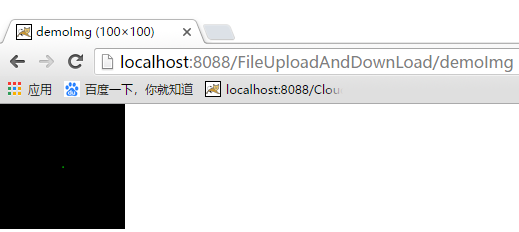
使用Spring-MVC发送图片内容到网页,并实现文件下载
使用Spring-MVC来实现Servlet能实现的功能,代码将更加简单,如发送图片到网页显示,只需要配置控制器即可,并且使用@ResponseBody注解,可实现向浏览器发送数据,这次发送的数据不一定是JSON,可能是图片字节数组,也可能是Excel的字节数组。如下代码实现了图片发送和文件下载。主要参考协议RFC2616来完成。
1 package Web; 2 3 import java.awt.image.BufferedImage; 4 import java.io.ByteArrayOutputStream; 5 import java.io.IOException; 6 7 import javax.imageio.ImageIO; 8 import javax.servlet.http.HttpServletResponse; 9 10 import org.apache.poi.hssf.usermodel.HSSFCell; 11 import org.apache.poi.hssf.usermodel.HSSFRow; 12 import org.apache.poi.hssf.usermodel.HSSFSheet; 13 import org.apache.poi.hssf.usermodel.HSSFWorkbook; 14 import org.springframework.stereotype.Controller; 15 import org.springframework.web.bind.annotation.RequestMapping; 16 import org.springframework.web.bind.annotation.ResponseBody; 17 18 /** 19 * 发送图片的控制器 20 * @author yangchaolin 21 * 22 */ 23 @Controller 24 @RequestMapping("/demo") 25 public class ImageController { 26 /** 27 * @ResponseBody 注解会自动处理控制返回值 28 * 1 当返回的类型为JavaBean(数组,集合),返回的数据为JSON 29 * 2 当返回的类型为byte数组,直接将byte数组装入响应消息的body 30 * 3 produces的配置相当如设置消息头Content-Type为image/png 31 */ 32 @RequestMapping(value="/imgController.do",produces="image/png") 33 @ResponseBody 34 public byte[] sendImageToWeb() throws IOException { 35 byte[] image=createImage(); 36 return image; 37 } 38 39 /** 40 * 下载图片需参考RFC2616 19.5.1 Content-Disposition 41 * 如果想下载图片,需要将Content-Type设置为application/octet-stream 42 * 另外还需要在响应消息头设置Content-Disposition 43 */ 44 @RequestMapping(value="/downloadImage.do",produces="application/octet-stream") 45 @ResponseBody 46 public byte[] downloadImageForWeb(HttpServletResponse response) throws IOException { 47 //example写法: Content-Disposition: attachment; filename="fname.ext" 48 response.setHeader("Content-Disposition", "attachment; filename="text.png"");// " 转义 " 49 return createImage(); 50 } 51 52 /** 53 * 生成excel,浏览器可以下载,类似图片下载 54 */ 55 @RequestMapping(value="/downloadExcel.do",produces="application/octet-stream") 56 @ResponseBody 57 public byte[] downloadExcelForWeb(HttpServletResponse response) throws IOException { 58 //example写法: Content-Disposition: attachment; filename="fname.ext" 59 response.setHeader("Content-Disposition", "attachment; filename="text.xls"");// " 转义 " 60 return createExcel(); 61 } 62 63 /** 64 * 生成一个简单excel,并返回byte数组 65 */ 66 private byte[] createExcel() throws IOException { 67 //生成工作簿 68 HSSFWorkbook workbook=new HSSFWorkbook(); 69 //生成工作表 70 HSSFSheet sheet=workbook.createSheet("information"); 71 //创建一行 72 HSSFRow row=sheet.createRow(0);//第一行 73 //行中创建一个Cell 74 HSSFCell cell=row.createCell(0);//第一列 75 //Cell中写入数据 76 cell.setCellValue("hello excel with poi"); 77 //将Excel数据写入到输出流 78 ByteArrayOutputStream os=new ByteArrayOutputStream(); 79 workbook.write(os); 80 os.close(); 81 //使用输出流API,转换成byte数组并返回 82 byte[] excel=os.toByteArray(); 83 return excel; 84 } 85 86 /** 87 * 绘制一张图片,返回图片编码后的byte数组 88 */ 89 public byte[] createImage() throws IOException { 90 //使用BufferedImage绘图 91 //第一个参数图片宽度 92 //第二个参数图片高度 93 //第三个参数图片像素颜色表示方式,为3位的byte,一个byte调节一种颜色,分别为BGR,一个byte为8位,可以代表0-255的亮度 94 BufferedImage buffImage=new BufferedImage(100,100,BufferedImage.TYPE_3BYTE_BGR); 95 //设置图片某个像素点的颜色 96 buffImage.setRGB(50, 50, 0x00ff00);//使用16进制表示 97 ByteArrayOutputStream os=new ByteArrayOutputStream(); 98 //图片编码为png 99 ImageIO.write(buffImage, "png", os); 100 //关闭流 101 os.close(); 102 byte[] image=os.toByteArray(); 103 return image; 104 } 105 106 }
网页部分:
1 <!DOCTYPE html> 2 <html> 3 <head> 4 <meta charset="UTF-8"> 5 <title>web发送请求到服务端得到图片</title> 6 </head> 7 <body style="font-family:'微软雅黑'"> 8 9 <h1>以下为使用servlet从服务端得到的图片</h1> 10 <p> 11 <img alt="" src="demoImg"> <!-- demoImg为web.xml中配置好的访问路径 --> 12 </p> 13 14 <h1>以下为使用Spring MVC从服务端得到的图片</h1> 15 <p> 16 <img alt="" src="demo/imgController.do"> <!-- src里就是get请求地址 --> 17 </p> 18 19 <h1>以下为使用Spring MVC从服务器下载图片</h1> <!-- 下载图片,需参考RFC2616 19.5.1里的要求 --> 20 <a href="demo/downloadImage.do">下载图片</a> 21 22 <h1>以下为使用Spring MVC从服务器下载Excel</h1> <!-- 下载Excel,需参考RFC2616 19.5.1里的要求,类似图片下载,最后都是返回byte数组 --> 23 <a href="demo/downloadExcel.do">下载Excel</a> 24 33 </body> 34 </html>
网页显示:
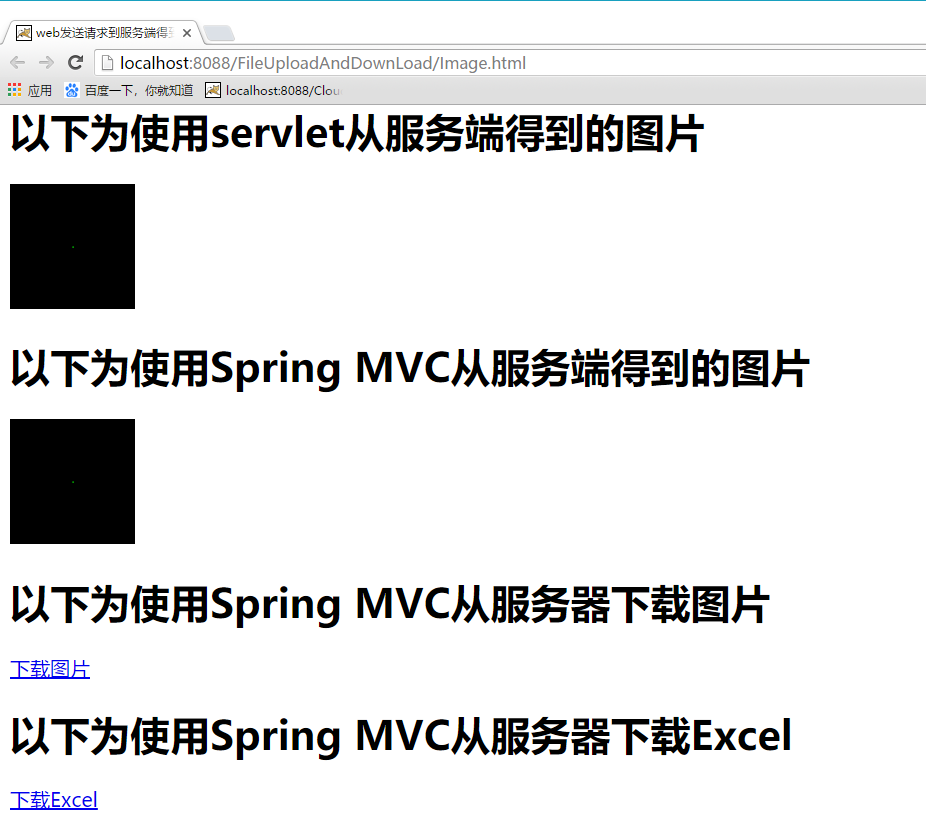
下载的图片和Excel在文件夹中:

RFC1867协议参考
文件的上传,参考文档 Form-based File Upload in HTML RFC1867,字面意思为基于Form表单的文件上传,其中在文档目录 2.HTML forms with file submission 里有一个example,示例用户如何通过表单上传文件。
<FORM ENCTYPE="multipart/form-data" ACTION="_URL_" METHOD=POST>
File to process: <INPUT NAME="userfile1" TYPE="file">
<INPUT TYPE="submit" VALUE="Send File">
</FORM>
发送的请求,必须为POST请求,此外还需要完成以下两步才能正常上载文件:
1 导入一个commons-fileupload包
2 在web.xml中进行解析器MultipartResolver的配置
解析器的配置方法参考spring-framework的文档目录 22.10.2 Using a MultipartResolver with Commons FileUpload,本文档使用版本4
使用Spring-MVC实现文件上传
使用Spring-MVC实现文件的上传,网页端除了使用传统Form表单提交方式,还可以使用AJAX的FormData来提交,前者是上传后会刷新页面,后者是不刷新页面。本项目中上传文件成功后,服务器将给浏览器发送一个Map,里面包含上传成功的信息,不再采用云笔记的JasonResult来返回数据,代码如下。
1 package Web; 2 3 import java.io.File; 4 import java.io.FileOutputStream; 5 import java.io.IOException; 6 import java.io.InputStream; 7 import java.util.HashMap; 8 import java.util.Map; 9 10 import org.springframework.stereotype.Controller; 11 import org.springframework.web.bind.annotation.RequestMapping; 12 import org.springframework.web.bind.annotation.ResponseBody; 13 import org.springframework.web.multipart.MultipartFile; 14 15 /** 16 * 上传文件的控制器 17 * @author yangchaolin 18 * 19 */ 20 @Controller 21 @RequestMapping("/file") 22 public class UploadController { 23 24 @RequestMapping("/uploadFile.do") 25 @ResponseBody 26 public Object uploadFile(MultipartFile userfile1,MultipartFile userfile2) throws IllegalStateException, IOException{ 27 /** 28 * Spring MVC中可以使用MultipartFile接受上载的文件,文件中的一切数据都可以从此对象中获取 29 * 比如可以获取文件原始名,文件类型等 30 */ 31 32 //比如获取上载文件的原始文件名,就是文件系统中的文件名 33 String filename1=userfile1.getOriginalFilename(); 34 String filename2=userfile2.getOriginalFilename(); 35 System.out.println("文件1原始文件名为:"+filename1); 36 System.out.println("文件2原始文件名为:"+filename2); 37 38 Map<String,String> map=new HashMap<String,String>(); 39 40 /** 41 * 保存上传的文件有三种方法: 42 * 1 MultipartFile接口的transferTo(File dest)方法 43 * 将文件直接保存到目标文件,适用于大文件 44 * 2 MultipartFile接口的getBytes()方法 45 * 将文件全部读取,返回byte数组,保存在内存,适用于小文件,大文件有爆内存风险 46 * 3 MultipartFile接口的getInputStream()方法,将文件读取后返回一个InputStream 47 * 获取上载文件的流,适用于大文件 48 */ 49 50 //mac中保存文件地址 /Users/yangchaolin 51 //window中保存地址 D:/yangchaolin 52 //linux中保存地址 /home/soft01/yangchaolin 53 54 //1 使用transferTo(File dest) 55 // 创建目标文件夹 56 File dir=new File("F:/FileUploadAndDownload"); 57 boolean makeDirectoryResult=dir.mkdirs(); 58 System.out.println("文件夹路径是否建立:"+makeDirectoryResult); 59 //往文件夹放第一个文件 60 File file=new File(dir,filename1); 61 userfile1.transferTo(file); 62 63 /** 64 * transferTo方法如果不注释掉,后面执行第二种方法写入文件到硬盘会报错 65 * 报错内容:java.lang.IllegalStateException: File has been moved - cannot be read again 66 * 原因为transferTo方法底层在执行时,会检查需要写入到OutputStream的文件字节数是否超过MultipartResolver配置的大小, 67 * 默认设置为10kib,如果超过了,执行完这个方法后会从内存中删除上传的文件,后面再想读取就会报错 68 */ 69 70 //2 使用getInputStream()方法 71 File file1=new File(dir,filename1); 72 InputStream isWithoutBuff=userfile1.getInputStream(); 73 //使用FileoutputStream写出到文件 74 FileOutputStream fosWithoutbuff=new FileOutputStream(file1); 75 //InputStream一个字节一个字节的读取,将读取到的结果写入到FileOutputStream 76 int b;//读取一个byte后,以int类型显示数值,范围0~255 77 while((b=isWithoutBuff.read())!=-1) { 78 //read()方法每次只读取文件的一个byte 79 fosWithoutbuff.write(b); 80 } 81 isWithoutBuff.close(); 82 fosWithoutbuff.close(); 83 84 //同样使用InputStream读取,将读取到的结果写入到FileOutputStream,但使用了缓冲字节数组 85 File file2=new File(dir,filename2); 86 InputStream isWithBuff=userfile2.getInputStream(); 87 FileOutputStream fosWithBuff=new FileOutputStream(file2); 88 int n;//保存返回读取到的字节数, 一次8192个字节,当不够时就是实际读取到的字节数 89 byte[] buff=new byte[8*1024];//8kib的缓冲字节数组 90 while((n=isWithBuff.read(buff))!=-1) { 91 System.out.println("读取后的字节数:"+n); 92 fosWithBuff.write(buff, 0, n); 93 } 94 isWithBuff.close(); 95 fosWithBuff.close(); 96 97 //3 使用getBytes()方法 98 byte[] data=userfile2.getBytes(); 99 //写出byte数组到文件 100 File file3=new File(dir,filename2); 101 FileOutputStream fosWithByte=new FileOutputStream(file3); 102 fosWithByte.write(data,0,data.length); 103 fosWithByte.close(); 104 105 map.put("Result", "upload Success"); 106 107 return map;//需要导入jackson的三个核心包,否则无法正常转换成JSON 108 109 } 110 111 }
传统Form表单提交:
1 <h1>以下为使用Spring MVC上载图片</h1> 2 <form method="post" action="file/uploadFile.do" enctype="multipart/form-data"> 3 file to process:<br> 4 <input type="file" name="userfile1"/> <!-- name用于提交到服务器的表单数据进行标识 --> 5 <input type="file" name="userfile2"/> 6 <input type="submit" value="upload文件"/> 7 </form>
网页显示:

文件上传结果:

AJAX提交的方式,服务端无需修改,只需要修改浏览器端代码即可:
AJAX文件上载,参考项目FileUploadAndDownLoad ,AJAX上传适用于最新的浏览器版本,老版本的可能不兼容,使用FormData()来上传文件,FormData类似于Form,对于前面Spring MVC上传文件的方式:
1 不使用AJAX,客户端需使用form来实现文件上传,form表单里有input元素,通过input元素的name属性来标识上传文件的资源,利用commons-fileupload包,客户端上传的文件会保存在MultipartFile对象中,然后可再通过三种方式,将上传的文件写入到硬盘。
2 使用AJAX,客户端不需要写form表单,文件资源将直接保存到FormData里面,然后传入服务器,服务端的处理跟前面第一种没有区别,只是保存到FormData里的标识符,需要跟服务端方法里的参数名字一样。
1 <!DOCTYPE html> 2 <html> 3 <head> 4 <meta charset="UTF-8"> 5 <title>使用AJAX上传文件</title> 6 <script type="text/javascript" src="scripts/jquery.min.js"></script> 7 <script type="text/javascript"> 8 <!--使用AJAX来上传数据--> 9 $(function(){ 10 $("#uploadFile").bind("click",uploadFileWithAJAX); 11 }); 12 function uploadFileWithAJAX(){ 13 //获取文件,将文件保存到FormData里 14 var file1=$("#file1")[0].files[0];//jQuery对象转换成DOM对象,然后使用DOM对象的files属性,获取文件 15 var file2=$("#file2")[0].files[0]; 16 //创建内存中的表单对象 17 var formdata=new FormData(); 18 //第一个参数,必须和服务端MultipartFile的参数名一样 19 formdata.append("userfile1",file1); 20 formdata.append("userfile2",file2); 21 22 //发送ajax请求 23 $.ajax({ 24 url:"file/uploadFile.do", 25 type:"POST", 26 data:formdata, 27 dataType:"JSON", 28 cache:false, 29 processData:false, 30 contentType:false, 31 success:function(resultData){ 32 console.log(resultData); 33 if(resultData.Result=="upload Success"){ 34 $("#result").text("upload Success"); 35 } 36 }, 37 error:function(e){ 38 console.log("网络错误"); 39 } 40 }); 41 42 } 43 </script> 44 </head> 45 <body> 46 47 <h1>以下为使用AJAX上传文件,服务端代码不用变</h1> 48 <input type="file" id="file1"><br> 49 <input type="file" id="file2"><br> 50 <input type="submit" value="上传图片" id="uploadFile"><br> 51 <div id="result"></div> 52 53 </body> 54 </html>
网页显示:
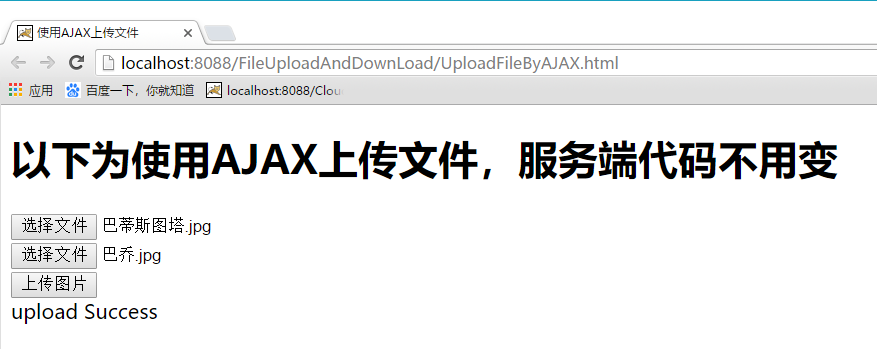
文件上传结果:

总结
(1)无论是文件的上传,下载还是显示,都需要参考协议,其中上传参考RFC1867,下载参考RFC2616,此外还需要参考Spring-Framework的文档
(2)使用Spring注解@ResponseBody不仅仅可以返回JSON,还可以返回byte数组
(3)文件的上传可以使用AJAX,并使用FormData完成文件上传